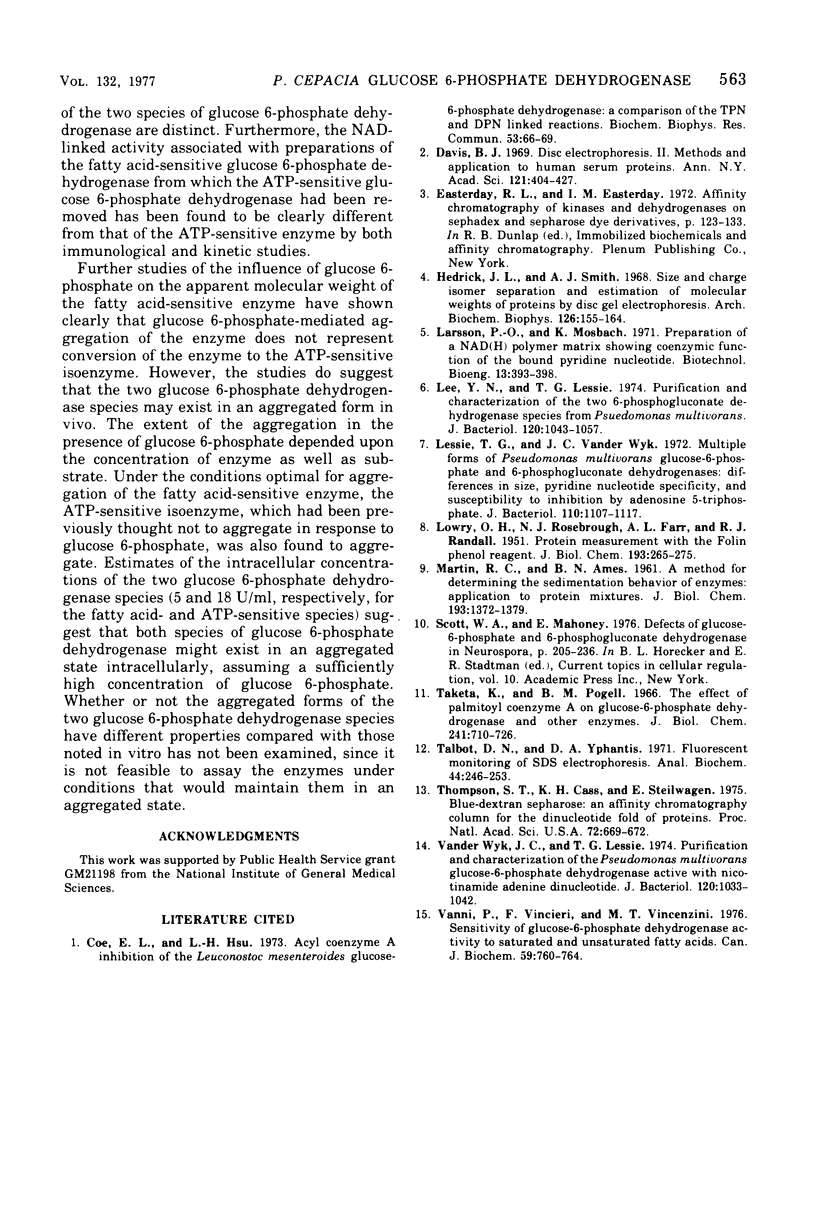Abstract
The adenosone 5'-triphosphate-insensitive glucose 6-phosphate dehydrogenase from Pseudomonas cepacia has been found to be strongly inhibited by long-chain fatty acids and their acyl coenzyme A esters, suggesting that an important role of this isoenzyme might be to provide reduced nicotinamide adenine dinucleotide phosphate for reductive steps in fatty acid synthesis. The enzyme, which has been redesignated the fatty acid-sensitive glucose 6-phosphate dehydrogenase, has been purified to homogeneity using affinity chromatography with nicotinamide adenine dinulceotide phosphate-substituted Sepharose as a key step in the purification. The purified preparations were used to study the immunological properties and subunit composition of the enzyme and its relationship to the adenosine 5'-triphosphate-sensitive glucose 6-phosphate dehydrogenase present in extracts of P. cepacia. Although both enzymes were found to be composed of similar size subunits of about 60,000 daltons, immunological studies failed to demonstrate any antigenic similarity between them. Studies of the sedimentation behavior of the fatty acid-sensitive enzyme in sucrose gradients indicated that its apparent molecular weight is increased in the presence of glucose 6-phosphate and suggest that it may exist in an aggregated state in vivo. Palmitoyl coenzyme A, which strongly inhibited the enzyme, failed to influence its sedimentation behavior.
Full text
PDF








Selected References
These references are in PubMed. This may not be the complete list of references from this article.
- Coe E. L., Hsu L. H. Acyl coenzyme A inhibition of Leuconostoc mesenteroides glucose-6-phosphate dehydrogenase: a comparison of the TPN and DPN linked reactions. Biochem Biophys Res Commun. 1973 Jul 2;53(1):66–69. doi: 10.1016/0006-291x(73)91401-0. [DOI] [PubMed] [Google Scholar]
- DAVIS B. J. DISC ELECTROPHORESIS. II. METHOD AND APPLICATION TO HUMAN SERUM PROTEINS. Ann N Y Acad Sci. 1964 Dec 28;121:404–427. doi: 10.1111/j.1749-6632.1964.tb14213.x. [DOI] [PubMed] [Google Scholar]
- Hedrick J. L., Smith A. J. Size and charge isomer separation and estimation of molecular weights of proteins by disc gel electrophoresis. Arch Biochem Biophys. 1968 Jul;126(1):155–164. doi: 10.1016/0003-9861(68)90569-9. [DOI] [PubMed] [Google Scholar]
- LOWRY O. H., ROSEBROUGH N. J., FARR A. L., RANDALL R. J. Protein measurement with the Folin phenol reagent. J Biol Chem. 1951 Nov;193(1):265–275. [PubMed] [Google Scholar]
- Larsson P. O., Mosbach K. Preparation of a NAD(H)-polymer matrix showing coenzyme function of the bound pyridine nucleotide. Biotechnol Bioeng. 1971 May;13(3):393–398. doi: 10.1002/bit.260130306. [DOI] [PubMed] [Google Scholar]
- Lee Y. N., Lessie T. G. Purification and characterization of the two 6-phosphogluconate dehydrogenase species from Pseudomonas multivorans. J Bacteriol. 1974 Dec;120(3):1043–1057. doi: 10.1128/jb.120.3.1043-1057.1974. [DOI] [PMC free article] [PubMed] [Google Scholar]
- Lessie T. G., Wyk J. C. Multiple forms of Pseudomonas multivorans glucose-6-phosphate and 6-phosphogluconate dehydrogenases: differences in size, pyridine nucleotide specificity, and susceptibility to inhibition by adenosine 5'-triphosphate. J Bacteriol. 1972 Jun;110(3):1107–1117. doi: 10.1128/jb.110.3.1107-1117.1972. [DOI] [PMC free article] [PubMed] [Google Scholar]
- MARTIN R. G., AMES B. N. A method for determining the sedimentation behavior of enzymes: application to protein mixtures. J Biol Chem. 1961 May;236:1372–1379. [PubMed] [Google Scholar]
- Scott W. A., Mahoney E. Defects of glucose-6-phosphate and 6-phosphogluconate dehydrogenases in Neurospora and their pleiotropic effects. Curr Top Cell Regul. 1976;10:205–236. doi: 10.1016/b978-0-12-152810-2.50012-7. [DOI] [PubMed] [Google Scholar]
- Taketa K., Pogell B. M. The effect of palmityl coenzyme A on glucose 6-phosphate dehydrogenase and other enzymes. J Biol Chem. 1966 Feb 10;241(3):720–726. [PubMed] [Google Scholar]
- Talbot D. N., Yphantis D. A. Fluorescent monitoring of SDS gel electrophoresis. Anal Biochem. 1971 Nov;44(1):246–253. doi: 10.1016/0003-2697(71)90367-8. [DOI] [PubMed] [Google Scholar]
- Thompson S. T., Cass K. H., Stellwagen E. Blue dextran-sepharose: an affinity column for the dinucleotide fold in proteins. Proc Natl Acad Sci U S A. 1975 Feb;72(2):669–672. doi: 10.1073/pnas.72.2.669. [DOI] [PMC free article] [PubMed] [Google Scholar]
- Vander Wyk J. C., Lessie T. G. Purification and characterization of the Pseudomonas multivorans glucose-6-phosphate dehydrogenase active with nicotinamide adenine dinucleotide. J Bacteriol. 1974 Dec;120(3):1033–1042. doi: 10.1128/jb.120.3.1033-1042.1974. [DOI] [PMC free article] [PubMed] [Google Scholar]
- Vanni P., Vincieri F., Vincenzini M. T. Sensitivty of glucose-6-phosphate dehydrogenase activity to saturated and unsaturated fatty acids. Can J Biochem. 1976 Aug;54(8):760–764. doi: 10.1139/o76-108. [DOI] [PubMed] [Google Scholar]


